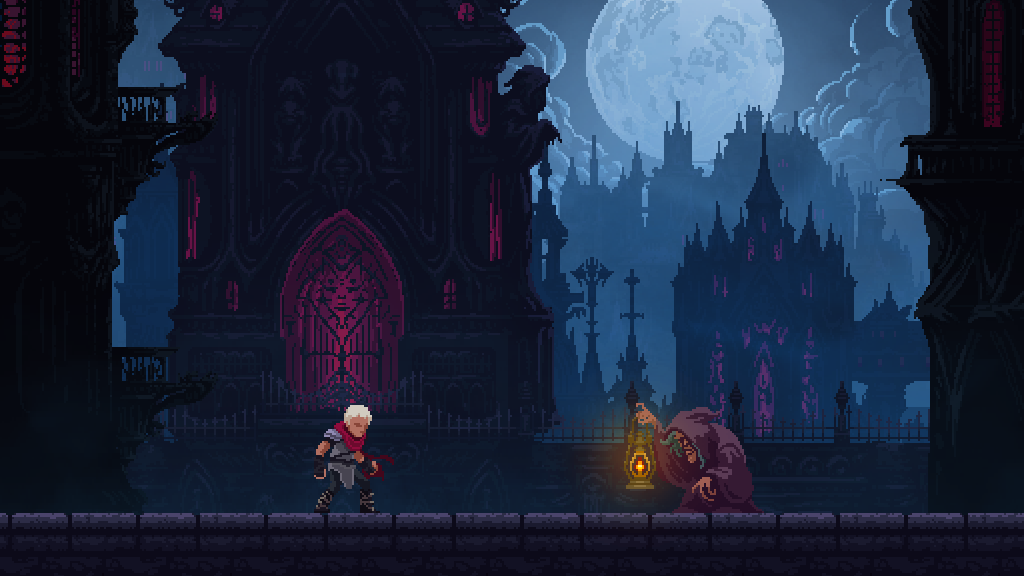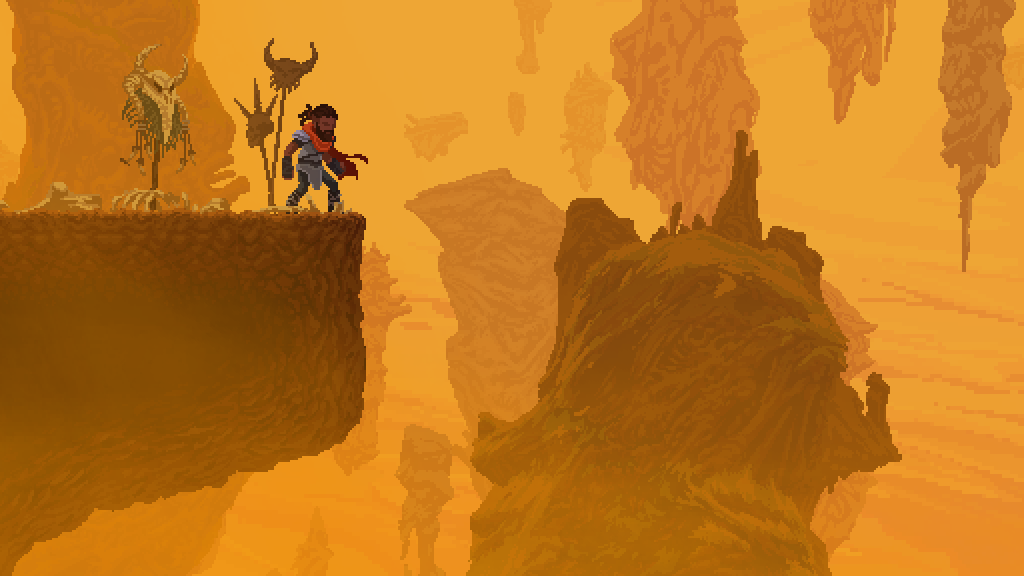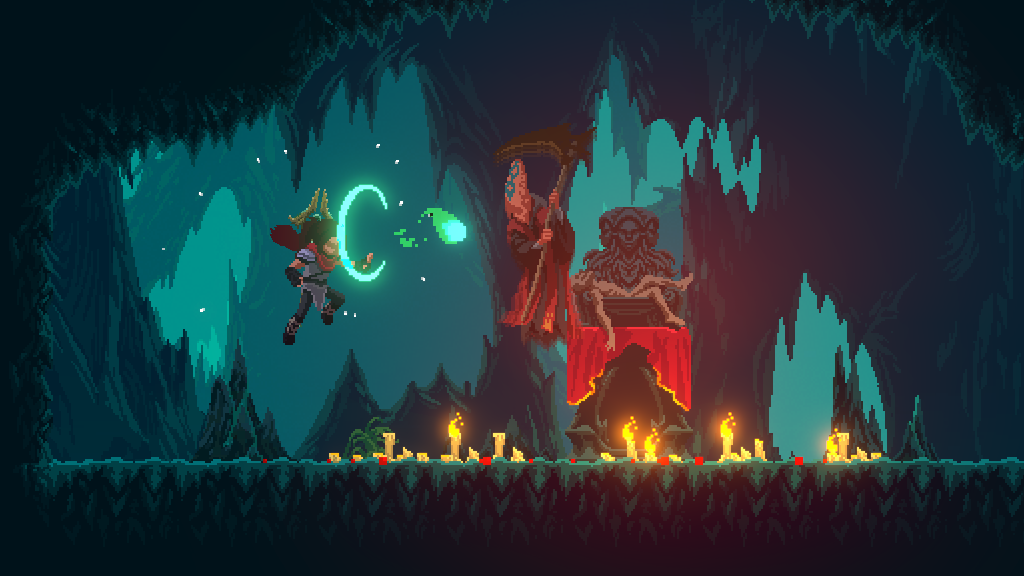On a fundamental level, Elderand is a “decent” game. It controls wonderfully, has a host of different locales with vibrant art direction, features a decent OST, and includes all the mechanics and gameplay tropes one might expect from a modern metroidvania. But in the steadily growing sea of metroidvanias, Elderand barely makes a splash.
The story is as basic as it gets. A mysterious entity known as Sserthis has tarnished an ancient land. You take on the role of a nameless mercenary who might be able to save this land. This is about as much direct exposition as you’re going to get till you finish the game six to ten hours later. Indirect and environmental storytelling is the main way Elderand tries to invest players in its lore, but little of it truly kept my interest when I played.
However, the land of Elderand itself is a fairly interesting setting to explore, if for no other reason than the eye candy that it offers. Indeed, the sheer aesthetic quality and variety you encounter over your playthrough are among Elderand’s greatest strengths. From gloomy castles to crab-infested hellscapes, Elderand strikes a wonderful balance of familiar fantasy environments more experimental locales.
The compact size of the maps, on the other hand, is less of a clear-cut positive. The generous fast travel system combined with few overall mobility unlocks makes for an unusually smooth world traversal experience. I’ve never felt so confident in my sense of direction while playing a metroidvania, and for the first time didn’t feel even the slightest sense of dread at the thought of having to backtrack through all the starting areas for the loot I had missed. But this comes at the cost of a noticeable lack of excitement when you’re going through the world, even for the first time. Mid-game areas suffer from this the most as they’re often long, extended corridors, with few meaningful shortcuts within each level.
Compounding this issue, parts of Elderand’s player progression don’t feel like they were given much of a second look. Generic stat upgrades are about the most meaningful things you can expect to find in secret areas and chests, while almost all the best gear in the game is sold by the readily available vendor. The early introduction of double jump, usually a mid- to late-game unlock in modern metroidvanias, is a pleasant surprise that is almost immediately overshadowed by the lack of any other early-game movement unlocks. Elderand was so close to having actual interesting breaks from the formula but instead chooses to shuffle the pieces around, which was frustrating at the best of times.
In particular, I want to point out the ridiculousness of locking mid-air dashing behind a late-game area when the player can dash perfectly fine on the ground from the start. This felt no different from games that can’t be bothered to do more than place shin-high “obstacles” without a proper jumping mechanic to gate map progression. It might make sense mechanically but otherwise yanks you out of the experience completely.
The clunkiness of gear and movement unlocks, unfortunately, bleeds into the core combat as well. Attacks require you to be stationary and have an unusual amount of backswing. It isn’t too much of an issue when using a shield, but it becomes absolutely exasperating with faster weapons like the daggers, which rely on a dodge for defense. Ranged options are technically available in the form of magic staves and bows. However, both are so heavily resource gated by slow mana regeneration and ammunition respectively that they were difficult to make work as actual builds.
It’s a shame because Elderand’s combat is quite satisfying otherwise. The feedback on every blow that you land tickles all the right parts of your brain and makes for a great foundation for some meaty combat. Enemy death animations deserve a special mention for the unusual, but much-appreciated, amount of gruesome detail they contain. The blend of gore fitting for a slasher movie and humble, somewhat cutesy-looking pixel art has always struck a morbid chord with me, and Elderand certainly does not miss in this area.
Every melee weapon type boasts a decent amount of variety, although this is mostly just window dressing for a straightforward upgrade system. The game at least has the good sense to space out most of the weapon unlocks for builds so that upgrading early-game gear doesn’t feel like a complete waste of time. But the fact that there is no interesting quirk to almost any piece of late-game gear beyond superficial word changes left me bored near the end of my playthrough.
This should be the part where build variety comes into play to make up for this lack of gear diversity. In theory, health, strength, dexterity, and magic are the four stats you can allocate your hard-earned leveling points to. But in practice, the way weapons scale off of only one stat severely limits your build variety. There is no point in leveling any stat that isn’t health beyond whichever one your main weapon scales with. If you do attempt a balanced statline, enemy encounters will quickly spiral into dull, drawn-out skirmishes. Strength is just about the only offensive stat worth leveling outside of a dedicated strength build because it also increases stamina. Dexterity and magic otherwise require far too much investment to see any meaningful return. Respeccing only becomes available deep into the lategame and at that point, you will also need to painstakingly farm out upgrade materials to get the new weapon for your build up to speed.
At the end of the day, Elderand feels more like a game you play in between big releases or to scratch a certain itch, more than a title you might get excited to play. The individual flaws of the game might not be absolute dealbreakers, but they undoubtedly muddy the waters and noticeably drag down the experience. A sale is the only time I would recommend people try out Elderand, but with genre giants like Hollow Knight and Ori and The Will of the Wisps all at a similar price point, Elderand remains a hard sell.





